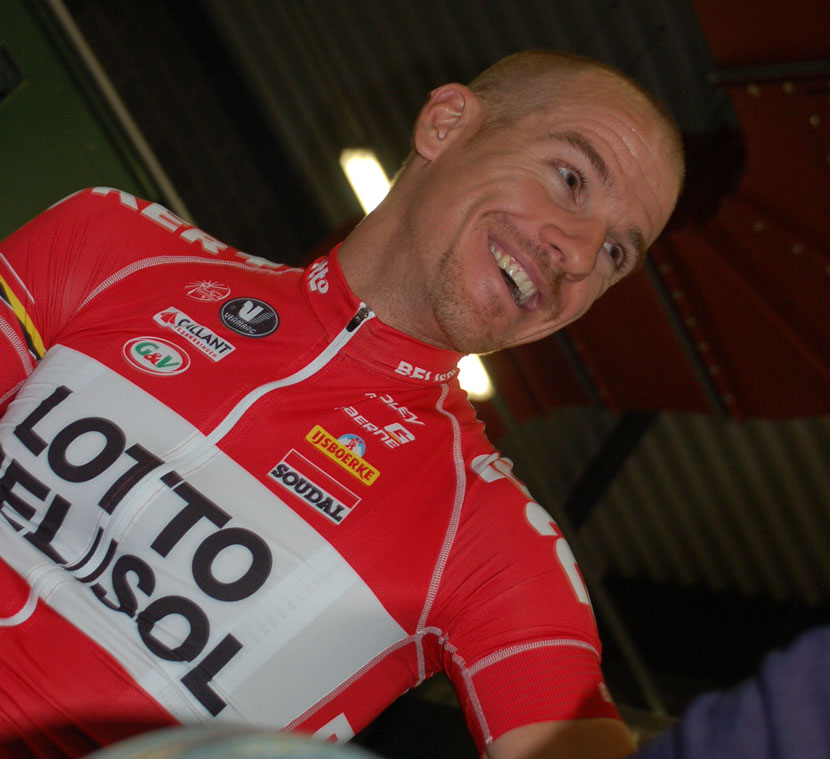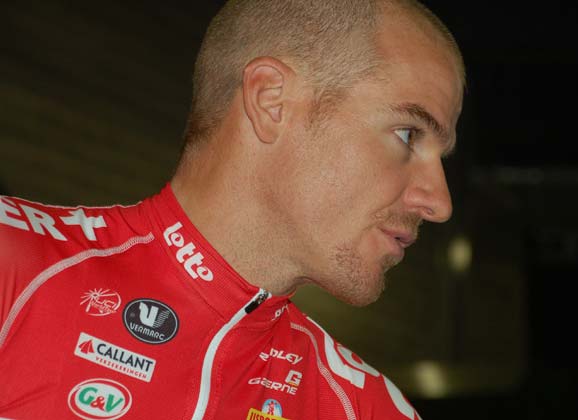After rolling down off the stage, past the photographers and media corp that awaited the riders backstage of the Leeds Arena on the night of the opening ceremony, Adam Hansen came to a halt at a barricade near the exit of the new complex. “Are we going to have a chat?” he asked. I nodded and replied, “That’s the plan. Do you have a minute?” He had 10.
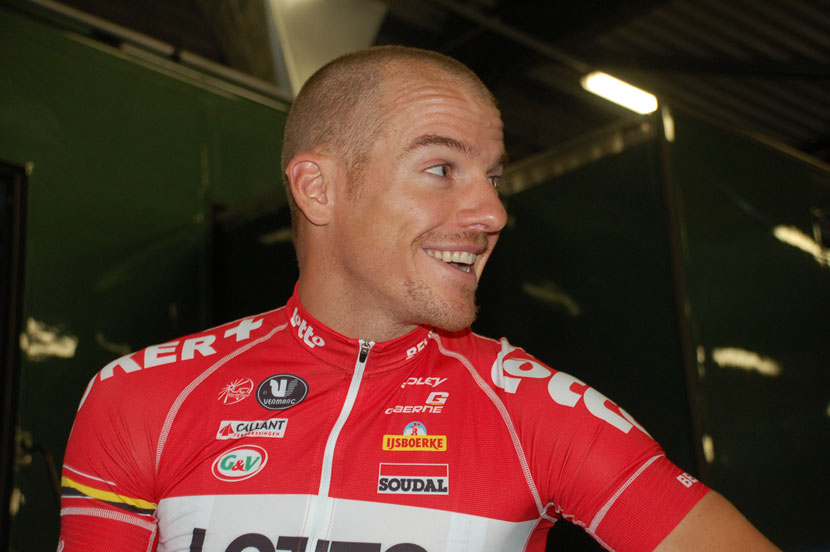
– By Rob Arnold
Before we formally began our interview the charismatic 33-year-old asked a few questions of his own, one in particular made this editor happy: “When can I write regularly in your magazine?”
“Every issue if you like.” It’s an easy answer. He’s an interesting character who sees cycling – and many other things in life – from a different perspective.
“We spoke about this a year ago,” he reminded me about a discussion at the harbour in Porto Vecchio on the Thursday before the 100th Tour de France, “and I’m really keen to write.”
“Please do. I’ll just send you reminders four times a year and all you’ve then got to do is send in your article.”
Another nod. The accord was struck. And so, ladies and gentleman, here is a quick chat with RIDE’s new regular columnist: Mr Adam Hansen.
Amongst other things, we talk about his professional lives – both of them – as well as tactics for the sprint and the value of lessons learned from recent broadcasts of sprint finishes using cameras on bikes, the sequence of his team’s lead-out train, and the dramatic changes to his position on the pedals…

Adam Hansen takes 10 minutes to chat after the team presentation.
Photo: John Thompson-Mills
* * * * *
It’s worth noting that in both 2012 and 2013 he started and finished all three Grand Tours each season – Giro, Tour, Vuelta – winning a stage of the Italian race last year and always diligently doing his duties for his Lotto-Belisol team. His resilience is one aspect of his cycling career that captures the attention of fans and media alike. His consistency is well-documented and there are many other things about Hansen that are interesting, some of which have been published by RIDE Media in the past, some are yet to be shared in future issues of our magazines.
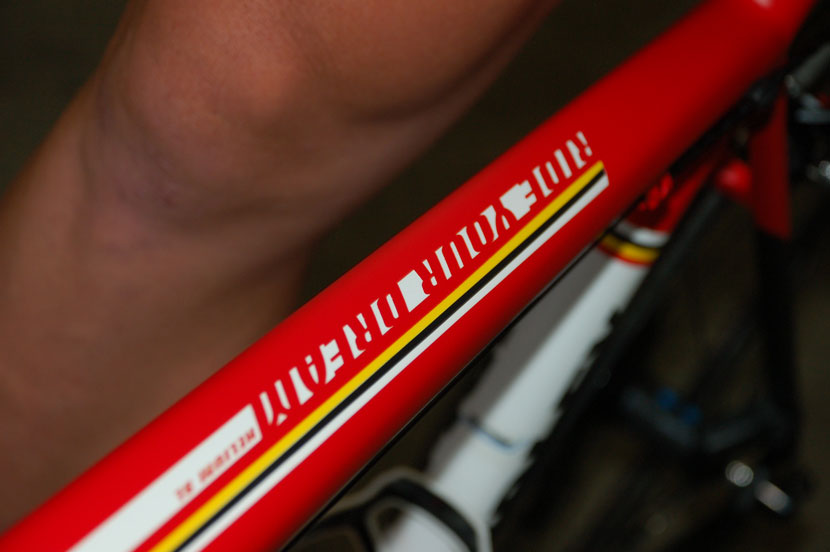
Once he stepped off his bike, made himself comfortable sitting on the top tube of his Ridley and explained that he was ready to settle in for a long discussion, I told him: “I’m not going to ask anything about the succession of Grand Tours, because you’ve just gone through that rigmarole… So,” I asked, “tell me what you want to talk about?”
“Cycling.”
“Good. Let’s begin.”
Here is a transcript of the discussion that followed…
RIDE: What do we need to know about the last few weeks? Is there anything that’s new or different?
Adam Hansen: “No, things are the same. Things get very repetitive now with my race program which is good – I know what I’m in for.
“[Jurgen] van den Broeck is flying. I have to be flying. I was nervous watching the Dauphiné because I could see how good he is. But obviously we’re also going for stage wins with André Greipel and it’s going to be difficult.
“With myself things are good: I’m healthy, I haven’t been sick for a very long time so that’s always a good sign.”
Do you ever get tired? Or, rather, do you ever get ‘cycling drain’ – when you just think, ‘I’d quite like to do something else for a bit…’?
“I live two different lives. I’m like a full cyclist at the races but then I go home and you would not recognise that I’m a cyclist. I live a totally different lifestyle when I’m home. I don’t really mix with cyclists, I’m very busy doing other things, and it’s just – how can I say it – I live opposite lives.
“When I finish a Grand Tour I switch off completely. I don’t touch my bike for a week. I’ll use that time to get a full recovery and just do something different. I have to. And I like this because I have total rest and I’m hungry to ride again so after a while I can get excited about riding which I need.
“I don’t understand how a lot of guys live in Girona and they go to races with cyclists, they go home and they’re surrounded by… cyclists. They say there’s 96 [pro] cyclists there and they can walk down the street and see four or five guys at the shops or cafe and they would be chatting about cycling. And, obviously, they go training with each other… for me that would be very difficult.
“I enjoy the life direction I’ve taken. I think it’s good – for me.”
Is there a change of home scene. I know you’ve got a new girlfriend… so are you still down where you’ve been living for a long time?
“I’m in the Czech Republic still and I’ll remain there. I do have a ‘new girlfriend’ – she is Belgian, she lives in Belgium, she rides for Lotto-Belisol, her name is Isabelle Beckers. She’s a lovely girl.”
But your professional life remains the same?
“Yep. Everything’s the same… well, do you mean: ‘cycling professional’ or my other work?”
[Note: Hansen has many other projects beyond his cycling. He has created a computer program that he has on-sold to numerous pro teams that essentially allows for greater interactivity between all staff and riders that lets the keep track of the many elements of the logistics and planning. We’ve written about it before in RIDE Cycling Review and, in the coming days, we’ll publish this interview online for some extra background for those interested in his ‘other work’.]
I meant cycling but I’m happy to hear about your other line of work too…
“Oh yeah, it’s all the same. It’s good. I’ve got the same program, I do the same job. Things are… ah, the team expects a little bit more from me but that’s okay, I’m trying to live up to that by being very consistent in all my races.”
For the Tour de France in 2014, can we talk a little about the sequence for the team… are you going to be the man who spends hour after hour on the front of the bunch?
“No. That’s Lars Bak. He’s going to do that. He controls it, brings the break in, and my job is to start the train. And I should get ‘Siebie’ [Marcel Sieberg] to the one-kilometre to go banner first. That’s my job.”
But you’re going from, what – 20 kilometres out?
“No. No, no, no… well, maybe. It obviously depends on when the break comes back and the race situation but I have to not ride in the front but keep the train well protected on the side or wherever it is we find ourselves. And it’s difficult because there are dangerous situations in the final where I have to give a little bit of effort before I should be doing my job. It might cost me some energy to get when I need to give it to the train. And sometimes I do ride a bit early – more for the safety of the other riders and to make sure we’re holding good position.
“Ideally I should be on the front of the bunch from two [kilometres to go] to one. But if I just sit back and don’t do anything until I’m meant to be up front, a wave of riders may come by and we could get boxed in. And it’s worse if I’m there and can’t do anything because I’ve spent my energy.
“Sometimes I do put in extra effort before but it’s worth taking that risk to ensure the riders are in good position.
“When the other trains come in, I’ll try and use those guys as well. It’s complicated.”
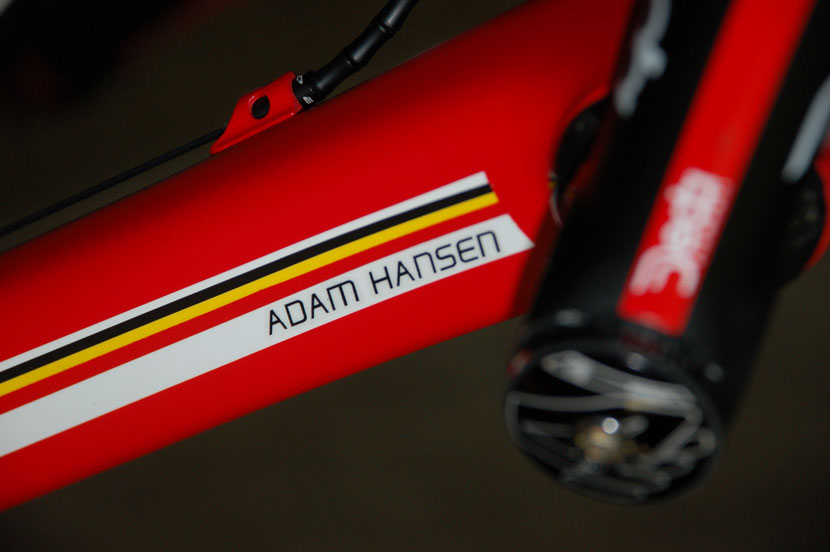
How helpful is it to see, for example, the footage from Giant-Shimano that has been uploaded on YouTube? Now people have got a better understanding of the complexities of a sprint because of the last few months [when the UCI has allowed on-bike cameras to be used in races in selected races].
“It’s really good what they have done. You see it’s not so simple. You don’t just ride your bike behind one guy who goes his maximum and then swings over before another guy goes maximum and swings over… it’s not like that.
“You’ve got guys everywhere. There are other trains next to us, they may box us in, we may lose a wheel, we might have to call out to the guy ahead and control the situation… you can lose a couple of positions and have to give an extra effort and, once you do that, well you’ve spent your energy you’d saved to use over there so you’ve got to recalculate… and there’s never a clear picture.
“When we see their footage, it’s a reminder of why we believe what we do is right – how our train works – and we don’t think we should change anything.”
You can see what their tactics are. I guess they’re giving away their secrets by broadcasting their footage. So have you learned anything about John Degenkolb, for example, from watching these clips?
“We have. And there were some comments that – well, I don’t want to bring up a negative thing, but he [Degenkolb] took his hands off the handlebars a few times, pushing riders… and this is a big no-no. It’s actually against the rules to do that: in a sprint, you’re not allowed to take you hands off the handlebars. He actually did that twice in one of the sprints. This is the only thing we really commented about.
“It’s not good for young guys to think, ‘Oh, the pros take their hands off the handlebars…’
“But yeah, we learn things about them by watching the footage.”
Would your team put cameras on the bikes?
“We were told that we would do that this year also.”
[Note: it was announced on 3 July 2014 that cameras would be allowed on bikes in the Tour de France for the first time. The official statement explains that “on-bike cameras make their debut at the Tour de France in a trial over three weeks of racing. Every day, four riders from two different teams will carry an ultra-light camera. They’ll turn it on themselves as they’ll approach the key moments of the race. After each stage, a video will be edited, published on letour.fr and available for team’s websites and broadcasters.”]
After having viewed the Giant-Shimano footage, how different is the Lotto-Belisol train from a riders’ perspective? From afar, your sequence looks more efficient…
“Yeah, we believe it is. Our train has always got the same order of riders and it has always been like that. It’s me, Siebie, Jurgie [Roelandts], Greg [Henderson], André [Greipel]. It’s always like that when the five of us are together.
“We’ve noticed the other trains tend to swap the order around.
“The thing with our train is: I cannot do anyone else’s job and no one can do my job. And it works down the line: no one else can do Siebie’s job… etc.
“We are all good at our own specific jobs and ours is really planned: it’s got to be the same every single time. Actually, I’ve never done a race where Jurgie has swapped with Greg, for example. But we’ve seen that the other teams do tend to change it a bit and they’re very strong and they’re very good but ours is… I won’t say ‘better’, but it’s very good.”
I’ve noticed that your feet are moving forward on your pedals. As in, the pedal is now more underneath the middle of your foot. Is it getting more extreme as time goes by? And, is anyone else adopting that?
“Ah, I don’t think anyone else is adopting it, but I do have two different cleat positions on different shoes. Depending on the type of stage, I do ride different positions.”
I’d expect that would alter everything after a sustained period of riding…
“Nah!”
Does it feel different not just on the bike but in the way your muscles behave after the stage?
“Well, I know some riders who complain if their seat is one millimetre out – it can be a huge problem but I go from a road bike to time trial bike… there are changes we have to adapt to all the time.
“Maybe my body is different and I can handle the differences but I have no problem changing cleat position. As long as everything is straight, as long as it’s even, then it’s no problem.”
Just give us a quick synopsis: when do you change and why?
“I’m more forward on the hilly stages and further back on a flat stage.”
And, compared with a ‘standard’ position, how far back is it in millimetres?
“We can talk in centimetres. It’s a lot. When I’m really far back, I’m around three or three-and-a-half centimetres back from a ‘standard’ position.”
It must feel funky. You must get extreme toe overlap [with the front wheel]…
“I do. I cross my front wheel by a lot. But I adapt.”
* * * * *
…and, with that, his team manager called for him to get on the bus.
We’ll stay in touch with Hansen during the Tour and look forward to seeing more from this unique character who isn’t afraid to speak his mind, experiment with equipment, or put himself on the line to help his team leaders achieve their ambitions.
If you have questions for Hansen that you’d like us to ask on your behalf, be sure to email them in during the Tour and we’ll be sure to pass them on.
